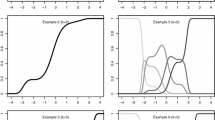Abstract
Standard procedures for estimating item parameters in item response theory (IRT) ignore collateral information that may be available about examinees, such as their standing on demographic and educational variables. This paper describes circumstances under which collateral information about examineesmay be used to make inferences about item parameters more precise, and circumstances under which itmust be used to obtain correct inferences.
Similar content being viewed by others
References
Andersen, E. B. (1973).Conditional inference and models for measuring. Copenhagen: Danish Institute for Mental Health.
Andersen, E. B. (1977). Sufficient statistics and latent trait models.Psychometrika, 42, 69–81.
Bartholomew, D. J. (1988). The sensitivity of latent trait analysis to choice of prior distribution.British Journal of Mathematical and Statistical Psychology, 41, 101–107.
Beaton, A. E. (1987).The NAEP 1983-84 technical report. Princeton, NJ: Educational Testing Service.
Bock, R. D., & Aitkin, M. (1981). Marginal maximum likelihood estimation of item parameters: An application of an EM algorithm.Psychometrika, 46, 443–459.
Bradley, R. A., & Gart, J. J. (1962). The asymptotic properties of ML estimators when sampling from associated populations.Biometrika, 49, 205–214.
Cohen, L. (1979). Approximate expressions for parameter estimates in the Rasch model.British Journal of Mathematical and Statistical Psychology, 32, 113–120.
Cressie, N., & Holland, P. W. (1983). Characterizing the manifest probabilities of latent trait models.Psychometrika, 48, 129–141.
de Leeuw, J., & Verhelst, N. (1986). Maximum likelihood estimation in generalized Rasch models.Journal of Educational Statistics, 11, 183–196.
Engelen, R. J. H. (1987). Semiparametric estimation in the Rasch model (Research Report 87-1). Twente, The Netherlands: Department of Education, University of Twente.
Kelderman, H. (1984). Loglinear Rasch model tests.Psychometrika, 49, 223–245.
Kendall, M., & Stuart, A. (1979).The advanced theory statistics, Volume 2. New York: MacMillan.
Kiefer, J., & Wolfowitz, J. (1956). Consistency of the maximum likelihood estimator in the presence of infinitely many incidental parameters,Annals of Mathematical Statistics, 27, 887–903.
Lindsay, B. (1987). Semiparametric estimation in the Rasch model. Unpublished manuscript. Department of Statistics, Pennsylvania State University, University Park, PA.
Little, R. J. A., & Rubin, D. B. (1987).Statistical analysis with missing data. New York: Wiley.
Louis, T. (1982). Finding the observed information matrix when using the EM algorithm.Journal of the Royal Statistical Society, Series B,44, 226–233.
Mislevy, R. J. (1987). Exploiting auxiliary information about examinees in the estimation of item parameters.Applied Psychological Measurement, 11, 81–91.
Mislevy, R. J., & Bock, R. D. (1983).BILOG: Item analysis and test scoring with binary logistic models. Mooresville, IN: Scientific Software.
Mislevy, R. J., & Sheehan, K. M. (in press). The information matrix in latent-variable models.Journal of Educational Statistics.
Neyman, J., & Scott, E. L. (1948). Consistent estimates based on partially consistent observations.Econometrika, 16, 1–32.
Orchard, T., & Woodbury, M. A. (1972). A missing information principle: Theory and applications.Procedings of the Sixth Berkeley Symposium on Mathematical Statistics and Probability. Berkeley: University of California Press.
Rasch, G. (1960).Probabilistic models for some intelligence and attainment tests. Copenhagen: Danish Institute for Educational Research.
Rubin, D. B. (1976). Inference and missing data.Biometrika, 63, 581–592.
Tjur, T. (1982). A connection between Rasch's item analysis model and a multiplicative Poisson model.Scandanavian Journal of Statistics, 9, 23–30.
Tsutakawa, R. K. (1984). Estimation of two-parameter logistic item response curves.Journal of Educational Statistics, 9, 263–276.
Author information
Authors and Affiliations
Additional information
This work was supported by Contract No. N00014-85-K-0683, project designation NR 150-539, from the Cognitive Science Program, Cognitive and Neural Sciences Division, Office of Naval Research. Reproduction in whole or in part is permitted for any purpose of the United States Government. We are indebted to Tim Davey, Eugene Johnson, and three anonymous referees for their comments on earlier versions of the paper.
Rights and permissions
About this article
Cite this article
Mislevy, R.J., Sheehan, K.M. The role of collateral information about examinees in item parameter estimation. Psychometrika 54, 661–679 (1989). https://doi.org/10.1007/BF02296402
Received:
Revised:
Issue Date:
DOI: https://doi.org/10.1007/BF02296402




